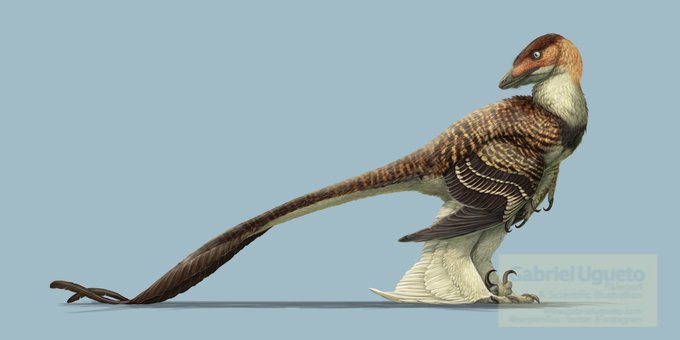sauridのTwitterイラスト検索結果。 628 件中 19ページ目
Dino Fact:
Xiongguanlong (Xiongguan Dragon) is an early Tyrannosaurid from Early Cretaceous China. It marked a turning point in Tyrannosaur evolution. Compared to other early tyrannosaurs, it was larger, more robust, and had smaller arms like later tyrannosaurs.
Art: JELSIN
Oxalaia quilombensis
(Based on the S. aegyptiacus skeletal by Sassy PaleoNerd (modified) and the O. quilombensis skull diagram by PaleoGeek)
#paleoart #drawing #FossilFriday #dinosaur #spinosauridae #Oxalaia #mesozoic
@rick_akker Iirc,his comic self was such a weird mix bag of Dinos. Called him a Megaraptor which was then said to be actually a Carnosaur but then said to be a Tyrannosaurid? It was weird
Allosaur fits him really well and especially with having longer and stronger arms in Beast Mode.
#SauropterygianSaturday? Ok, here are mine: the henodontid placodont Parahenodus atancensis, the simosaurid Paludidraco Parahenodus (we described both taxa back in 2018, from fossils recovered from the Upper Triassic site of El Atance, Spain), and the nothosaur Brevicaudosaurus.
Paleo stuff
Well there are:
Early unnamed prosauropod
Muttaburasaurus
Ouranosaurus
Albertaceratops
Styracosaurus
Brachiosaurus
Dromaeosaurid
For #FossilFriday, here's an open access article on cranial anatomy of Saurornitholestes langstoni from Dinosaur Park Formation by Phillip Currie and David C. Evans:
https://t.co/S9v33hWXvF
#paleontology #fossils #dinosaurs #Cretaceous #dromaeosauridae
Teratophoneus curriei
(Based on the skeletal made by Scott Hartman)
#paleoart #drawing #dinosaur #Teratophoneus #tyrannosauridae #theropod
Dino Fact:
Dineobellator (Diné Warrior) is a Dromaeosaurid from Late Cretaceous North America. Living at the very end of the Mesozoic period, it was evolving many advanced features, including stronger and more flexible hands and feet and a less stiff tail.
Art: BushViper165
Getting back into some #paleoart with a #Ankylosaurus Magniventris dinosaur skull study. The Ankylosauridae family is a interesting deep dive in prehistoric species diversity. def recommend.
Albertosaurus is the last known non #Trex tyrannosaurid from #Canada. It was more slender and smaller than its celebrity cousin, but could still reach ~10 meters long. Fossil evidence suggest they may have been highly social, pack-hunting #dinosaurs (Art credit: @weird_dog_thing)
Gorgosaurus libratus
(Based on the skeletal diagram by G.S. Paul and the muscular diagram by Matt Dempsey)
#paleoart #drawing #dinosaur #gorgosaurus #tyrannosauridae #theropod
New @PeerJLife study explores geology and taphonomy of a unique #tyrannosaurid bonebed from southern Utah and its implications for tyrannosaurid gregariousness
Full article https://t.co/6YfNU5iX2Z
@DenverMuseumNS @UArkansas @colbygeology @jcu
#EvolutionaryStudies #Paleontology
On this all-important Velociraptor Awareness Day, please enjoy Biomechanics of Dromaeosaurid Dinosaur Claws by Phillip L. Manning and colleagues:
https://t.co/DvUzxNREh3
#velociraptor #dinosaur #paleontology #fossils
Dino Fact:
Nodocephalosaurus (Knob headed lizard) is an ankylosaurid from Late Cretaceous New Mexico. Despite being from North America, its skull structure closely resembles that of Sachania and Tarchia from Asia, with lots of bulbous growths on top.
Art: José Carlos Cortés
Dino Fact:
Tarchia (Brainy One) is an ankylosaurid from Late Cretaceous Mongolia. It was named this as it had a larger brain compared to Saichania, another ankylosaur who coincidentally was found in the same area and named at the same time as Tarchia.
Art:tuomaskoivurinne
Dromaeosaurids remain some of my favorite non-avian dinosaurs to reconstruct. So here you have some Dromaeosaurids for today’s #SciArtTweetStorm Utahraptor, Wulong, Deinonychus and Sinornithosaurus #sciart #paleoart
A closer, better quality view of the head. I always imagine the heads of abelisaurids as being boldly patterned (for display purposes).
Incidentally, this is South America's fourth new abelisaurid since the start of 2020: the others are Niebla, Spectrovenator (shown here; from Zaher et al. 2020) & Tralkasaurus. #theropods #dinosaurs
Pretty exciting to see the new #abelisaurid #Llukalkan aliocranianus from the Santonian of Neuquén, #Argentina, just published in Journal of Vertebrate Paleontology by Federico Gianechini et al. Known from great remains! Cont... #dinosaurs












































